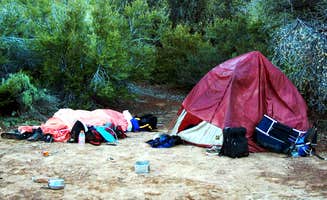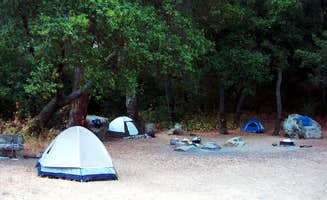Dispersed camping near New Cuyama, California provides rustic overnight options primarily on Bureau of Land Management property and Los Padres National Forest lands. The region sits at elevations ranging from 2,000-3,500 feet where temperatures fluctuate dramatically between seasons, with summer highs frequently exceeding 95°F and winter nighttime temperatures often dropping below freezing. Road conditions deteriorate quickly after rainfall, making high-clearance vehicles necessary for accessing most remote sites.
What to do
Hiking nearby trails: Chorro Grande Trail offers a challenging 9-mile route with primitive camping opportunities. According to Jessica P., who camped at Los Padres NF Dispersed Camp, "This site is next to chorro grande trail which is about a 9 mile hike. After your long hike if you want to rest go up the mountain site across and it's an awesome place to camp out."
Stargazing without equipment: The minimal light pollution makes Carrizo Plain National Monument ideal for astronomy enthusiasts. Jonathan E. notes, "The stars were also quite visible with minimal light pollution. The area is hilly and beautiful with enough flatness and openness to pitch a tent without issue."
Wildlife observation: The grasslands and hills surrounding Morrow Hill Dispersed camping areas provide opportunities for spotting native California wildlife. Mareike W. mentions, "We had a great and quiet night up there in our 21ft RV... Great view in the morning, beautiful."
What campers like
Isolation from crowds: Weekday camping at Carrizzo Plain National Monument offers exceptional solitude. Jonathan E. reports, "I didn't see anyone else around, nor did I see any wildlife, so it was very quiet and peaceful."
Windbreak locations: Finding natural shelter from prevailing winds improves the camping experience. Natalie T. explains her Carrizo Plain site: "Backtracked to a nice spot, camaflouged by a small hill, it'll protect my gear tent."
Compact vehicle accessibility: Several camping areas can accommodate smaller vehicles despite rough roads. At Old Sierra Madre, Elyse B. advises, "Pretty solid! Had great cell service and was a lovely drive to get there. Probably wouldn't recommend if you have a tent or RV as the spots were a little small and rocky."
Temperature variations: Winter campers should prepare for colder than forecast conditions. Jonathan E. warns about his January stay at Carrizo Plain: "It was about 15 degrees (F) colder than was forecasted (20 F vs 35 F) at night, so be prepared to be a bit chilly if visiting during the winter."
What you should know
Fire permit requirements: While some areas permit campfires with proper documentation, many impose seasonal bans. At Los Padres National Forest dispersed camping, Laura M. confirms, "Campfires are allowed with permit."
Cell service reality: Communication capabilities vary significantly by carrier and specific location. Laura M. notes, "Cell service is spotty with Verizon, AT&T and T-Mobile. Download map before you come so you don't camp on private land."
Road challenges: Roads become impassable for standard vehicles during and after precipitation. Gert K. experienced this at Carrizo Plain: "We drove a bit further down the main road than the gps location suggests, and took the next road to find a spot."
Private property boundaries: Camping on non-public land creates legal issues and potential confrontations. Mareike W. cautions at Morrow Hill, "Make sure, you really stay at the place up the hill (coordinates) otherwise the landlord will clarify that you're on private property."
Tips for camping with families
Wind protection strategy: Select campsites with natural windbreaks when traveling with children. At Chorma Camp in Matilija Wilderness, robherr warns, "Situated high on a bluff it gets lots of wind, and with very little shelter around to break it, if you camp here you will get the brunt of it."
Overnight temperature preparation: Pack significantly warmer sleeping gear than weather forecasts suggest, especially in winter. Jonathan E. recommends based on his experience at Carrizo Plain: "It was about 15 degrees (F) colder than was forecasted (20 F vs 35 F) at night."
Alternative campsites: Have backup locations identified in case primary sites prove unsuitable. One camper at Chorma Camp suggests, "Continuing on past Chorma if you can make it to Maple it is better campsite down in the valley."
Tips from RVers
Size limitations: Smaller RVs navigate access roads more successfully than larger models. Jacob B. at Figueroa Mountain Road Pullout 01 advises, "Easy spots to turn around and park. Beautiful views, slight road noise if you're not in the van but quiet inside. Wouldn't recommend anything bigger than a extended sprinter or transit."
Leveling challenges: Finding flat spots for larger vehicles requires preparation. Roland L. warns, "The site is all up hill and really only has a small area where a few vans can fit."
Road surface conditions: Washboarded dirt roads slow travel and can damage RVs. Laura M. shares her experience with a Class C RV: "The road in is wide and dirt with some washboard but fairly smooth overall... We had no trouble with our 26ft Class C."





